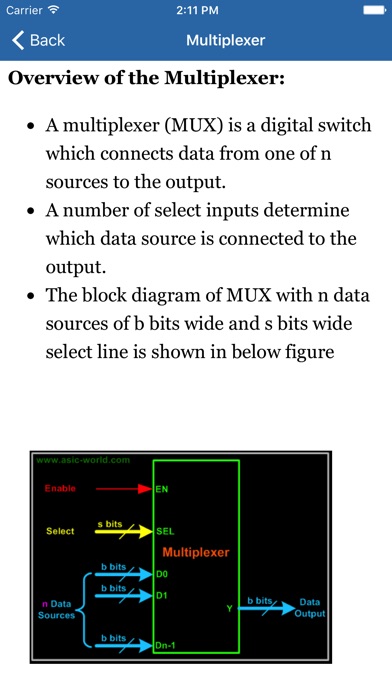
Digital Electronics is an important subject, common for Electrical, Electronics, and Instrumentation Engineering students. It deals with the theory and practical knowledge of Digital Systems and how they are implemented in various digital instruments. This App have been developed based on the latest GATE syllabus and will be useful for Electronics Engineering students as well as for GATE, IES and other PSU exams preparation.
Digital Electronics is an Electronics that uses binary numbers of 1 and 0 to represent information
1. Number Base System
1.1 Logic Operations
1.2 Mathematical Operations
1.3 Building Circuits with Breadboards
1.4 Digital Logic Gates
2. Logic Gates
2.1 Logic Gates/Fundamental Digital Gates
2.2 Logic Gates/Combinational Gates
2.3 Logic Gates/Basic Logic Gates Summary
2.4 Logic Gates Summary
3. Digital Device
3.1 Mathematic and Logic Operations
3.2 Synchronous Device
3.3 Asynchronous Device
4. Digital Signal Processing
4.1 Digital Data
4.2 Data Encoder
4.3 Data Selector
5. Digital Controllers
5.1 Controller Concepts
5.2 Arduino
5.3 Blinking Light
6. Communication Standards
6.1 Open Standards
6.2 ANSI
6.3 ISO
Some of the topics Covered in the app are:
1. Decimal System
2. Binary System
3. Representing Binary Quantities
4. Octal and Hexadecimal System
5. Binary-To-Decimal and Decimal-to-binary Conversion
6. Binary-To-Octal / Octal-To-Binary Conversion
7. Hexadecimal to Decimal/Decimal to Hexadecimal Conversion
8. Binary-To-Hexadecimal /Hexadecimal-To-Binary Conversion
9. Floating-Point Numbers
10. Binary Codes
11. Non Weighted Codes
12. Binary - Gray Code Conversion
13. Gray Code - Binary Conversion
14. Gray Code Applications
15. Alphanumeric Codes-ASCII code
16. EBCDIC code
17. Seven-segment Display Code
18. Error Detecting Codes
19. Error Correcting Codes.
20. Boolean Switching Algebras
21. Boolean Algebra Theorems
22. Minterms and Maxterms
23. Sum Of Products (SOP) and Product Of Sum (POS)
24. AND-Logic Gate
25. OR-Logic Gate
26. NOT-Logic Gate
27. NAND-Logic Gate
28. NOR-Logic Gate
29. XNOR-Logic Gate
30. Universal Gates
31. Realization of logic function using NAND gates
32. Realization of logic gates using NAND gates
33. Realization of logic function using NOR gates
34. Realization of logic gates using NOR gates.
35. Tristate Logic Gates
36. AND-OR-INVERT Gates
37. Schmitt Gates
38. Karnaugh Maps
39. Minimization Technique
40. 2-Variable K-Map
41. Grouping/Circling K-maps
42. Example of 2-Variable K-Map groups
43. 3-Variable K-Map
44. Example of 3-Variable K-Map
45. 4-Variable K-Map
46. Example of 4-Variable K-Map
47. 5-Variable K-Map
48. QUINE-Mccluskey minimization
49. QUINE-Mccluskey minimization Method-Example
50. Multiplexer
51. 2x1 Multiplexer
52. Design of a 2:1 Mux
53. 4:1 MUX
54. 8-to-1 multiplexer from Smaller MUX
55. 16-to-1 multiplexer from 4:1 mux
56. De-multiplexers
57. Mechanical Equivalent of a De-Multiplexer
58. 1-to-4 De-multiplexer
59. Boolean Function Implementation using Mux and de-Mux
60. 3-variable Function Using 4-to-1 mux
61. 2 to 4 Decoder using Demux
62. Arithmetic circuits-Adders
63. Full Adder
64. Full Adder using AND-OR
65. n-bit Carry Ripple Adder
66. 4-bit Carry Ripple Adder
67. Carry Look-Ahead Adder
68. BCD Adder
69. 2-digit BCD Adder
70. Subtracter
71. Full Subtracter
72. Parallel Binary Subtracter
73. Serial Binary Subtracter.
74. Comparators
75. Encoders
76. Decimal-to-Binary Encoder
77. Priority Encoder
78. Introduction to Sequential Circuit
79. Concept of Sequential Logic
80. Input enable signals
81. RS Latch
82. RS Latch with Clock
83. Setup and Hold Time
84. D Latch
85. JK Latch
86. T Latch
87. R-S Flip-Flop with Active LOW Inputs
88. R-S Flip-Flop with Active HIGH Inputs
89. R-S Flip-Flop Implementation with NOR gates
90. Clocked R-S Flip-Flop
Digital Electronics is part of electronics engineering education courses and technology degree programs of various universities.



